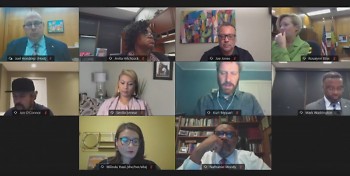
City leaders hear community feedback about funding for ShotSpotter in Grand Rapids, during a Nov. 10 City Commission meeting. /City of Grand Rapids

City leaders hear community feedback about funding for ShotSpotter in Grand Rapids, during a Nov. 10 City Commission meeting. /City of Grand Rapids
Grand Rapids city commissioners plan to vote Nov. 17 on allocating CARES Act or city police funds to a gunshot detection system for Grand Rapids.
Called ShotSpotter, the detection technology will cost around $500,000 for the first two years of its use, the commissioners said in a Tuesday City Commission meeting. Grand Rapids Police Department’s (GRPD) Chief Eric Payne said it will help reduce the city’s uptick in gun violence.
“Gun violence is the highest we’ve seen in at least 25 years,” said Payne during a Nov. 5 virtual town hall hosted by the GRPD. “Weapons firing is up 209 percent over last year, aggravated assault with gun is up over 65 percent, and homicides are up 200 percent.”
“I don’t believe ShotSpotter is the whole answer to this violence, but I do think it is a tool that would help us in reducing the violence,” he added.
ShotSpotter uses artificial intelligence, followed by remote human analysts, to detect, locate, and alert police on gunfire in less than 60 seconds, according to its website. This enables a rapid, precise response to render aid to victims and collect evidence that helps get violence perpetrators off the streets.
If approved, the ShotSpotter system would encompass a three square-mile radius on the city’s southeast side and a one square-mile radius on its northwest side, said Payne. These areas have been reported by the GRPD as having the city’s largest share of increased violence.
Payne and city commissioners have said funding for the first two years would come indirectly or directly from $500,000 in COVID-19 relief, or CARES Act, funds the Kent County Board of Commissioners reserved last month for Grand Rapids. Those funds are intended to stem the city’s increase in violence during the pandemic.
The legality of whether the CARES Act funds can be directly used for the ShotSpotter system is still being determined by the city and Kent County, Payne added in the Nov. 5 town hall.
“We have been working very closely with the county on trying to get funding through the CARES Act for crime prevention,” he said. “[The city’s] legal team has worked with their legal team. At this point we don't believe that the CARES funding qualifies for ShotSpotter. However, with that said, there are other things in our operations that we could utilize CARES funding for.”
The GRPD has been exploring other new crime prevention tools as part of its new three-year strategic plan aiming to improve police-community relations. Among them are the Cure Violence program, which would also require hundreds of thousands of dollars in funding.
If other crime prevention tools can be funded through the CARES Act dollars, Payne said, this would free up the GRPD to use other available funding for the ShotSpotter system.
Residents give feedback
As the GRPD, city, and county deliberate on how ShotSpotter in Grand Rapids would be funded, ahead of the Nov. 17 vote, the police department and city continue to encourage community feedback.
Over twenty resident callers gave their input on ShotSpotter funding during Tuesday’s City Commission meeting, held virtually, with a majority voicing their disapproval or skepticism. Likewise, last week’s two virtual town halls on the topic, hosted by the GRPD, produced more resident disapproval than approval.
Adam Sherman, a resident on the city’s southeast side, called into the Tuesday meeting, voicing his opposition to ShotSpotter funding. He said he attended both of the GRPD’s virtual town halls, and still hasn’t seen any actionable steps provided by Chief Payne on what the department’s process would be to remove ShotSpotter if it didn’t work as intended.
“ShotSpotter’s core purpose is to intimidate and over-police a four square-mile radius of Grand Rapids that it is supposedly to protect,” said Sherman. “We shouldn’t even be considering instituting some technology if we have no plan for how to remove it if it does not work the way it is advertised.”
A resident signaling approval for the ShotSpotter system was Justin McCarthy, a criminal defense attorney who also lives on the city’s southeast side. He spoke during the GRPD’s Nov. 2 town hall, with his approval contingent on residents’ privacy rights being respected.
“I live in an area on the southeast where every single night we are getting gunshots going off and, as it turns out, even I’ve had friends and neighbors who are calling 911 it seems like on a nightly basis,” McCarthy said. “In fact, while we’ve been doing this presentation, I received a ring alert that there was a gunshot and somebody injured fairly close to the Eastern Ave. area.”
“I think this is technology that’s very much needed in our community,” he continued, “provided it does not impinge upon people’s constitutional rights to be able to assemble outside, have conversations, and not have those conversations listened to.”
Grand Rapidians can continue to provide feedback to their city commissioners and the GRPD as the vote next week nears. Contact information for commissioners is available on the City of Grand Rapids’ website, with non-emergency contact information for the police department available on its website.
The Rapidian, a program of the 501(c)3 nonprofit Community Media Center, relies on the community’s support to help cover the cost of training reporters and publishing content.
We need your help.
If each of our readers and content creators who values this community platform help support its creation and maintenance, The Rapidian can continue to educate and facilitate a conversation around issues for years to come.
Please support The Rapidian and make a contribution today.